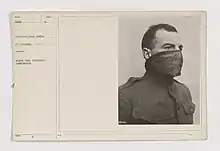Black Veil Respirator
The Black Veil Respirator was an early British gas mask designed by John Scott Haldane and introduced in May 1915.
History

The German army used chlorine as a poison gas for the first time against Allied troops at the Second Battle of Ypres on 22 April 1915.[1] As an immediate response, the British began issuing cotton wool wrapped in muslin to its troops by 3 May.[2] This was followed by the Black Veil Respirator, invented by John Scott Haldane. The Black Veil was a cotton pad soaked in an absorbent solution which was secured over the mouth using black cotton veiling.[3] The mask was treated in a solution of sodium hyposulphate, sodium carbonate, glycerine and water.[3] The solution retained sufficient moisture so that it was unnecessary to dip the mask in a solution prior to use, so long as it was stored in its purpose-built waterproof satchel. The veiling could be drawn up to cover the eyes, providing some protection against lachrymatory agents; however, the mask itself still only provided limited protection against chlorine gas.[4]
First issued on 20 May 1915, the Black Veil had a pouch for the pad to sit in and a string to hold the mask in to the face, and was thus an improvement to the hand-held cloth. However, it was of fragile construction, required training to use effectively, and largely immobilized its wearers because they were concerned about the mask coming loose.[5] The Black Veil Respirator was soon replaced by the British Smoke Hood, an over the head canvas hood treated with chlorine-absorbing chemicals, invented by Cluny MacPherson.[6][7] Following the introduction of the British Smoke Hood, the Black Veil was relegated to an emergency backup.
References
- "Second Battle of Ypres Begins". history.com. Retrieved April 22, 2018.
- Cook 1998, p. 8.
- Wetherell & Mathers 2007, p. 157.
- Spiers 2017, p. 156.
- Cook 1998, pp. 9-10.
- Victor Lefebure (1923). The Riddle of the Rhine: Chemical Strategy in Peace and War. The Chemical Foundation Inc. ISBN 0-585-23269-5.
- "Macpherson Gas Hood . Accession #980.222". The Rooms Provincial Museum Archives (St. John’s, NL). Retrieved August 5, 2017.
Bibliography
| Wikimedia Commons has media related to Black Veil Respirator. |
- Cook, Tim (1998). "Through Clouded Eyes:Gas Masks and the Canadian Corps i n the First World War". Material History Review (Spring ed.). 47: 4–18.CS1 maint: ref=harv (link)
- Spiers, Edward M. (2017), "The Gas War, 1915-1918: If not a War Winner, Hardly a Failure.", in Friedrich, Bretislav; Hoffmann, Dieter; Renn, Jürgen; Schmaltz, Florian; Wolf, Martin Chemical Warfare: Research, Deployment, Consequences (eds.), One Hundred Years of, Springer, pp. 153–178, ISBN 978-3319516639CS1 maint: ref=harv (link)
- Wetherell, Anthony; Mathers, George (2007), "Respiratory Protection", in Marrs, Timothy; Maynard, Robert; Sidell, Frederick (eds.), Chemical Warfare Agents: Toxicology and Treatment, New York: Wiley, pp. 157–174, ISBN 978-0470013595CS1 maint: ref=harv (link)